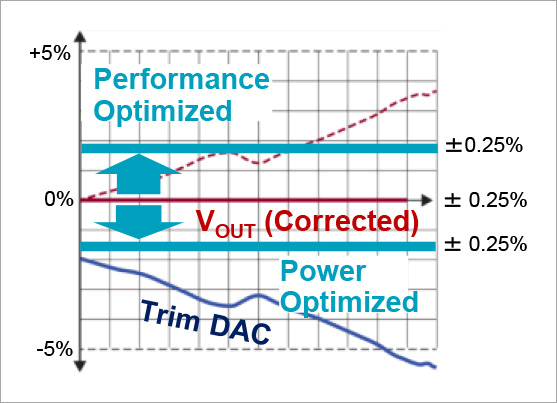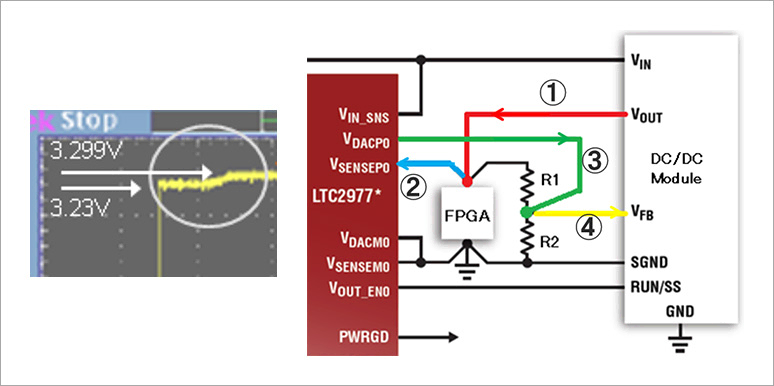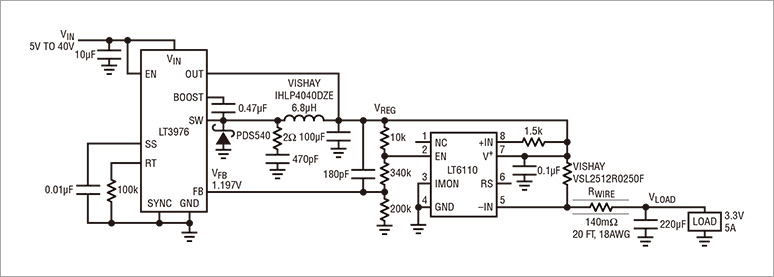The basic rule for the power supply of an electric circuit is to design the circuit board by using a solid pattern to reduce the impedance of the power supply and prevent voltage drop.
When module is embedded in the system
In the board design, the power can be supplied with low impedance by the solid pattern.
However, for the system power supply in the enclosure, FA camera, and motors that are combined to produce the final product or system, the power supply is connected by a cable.
At this time, a long cable (wiring) may become unavoidable, and the impedance of the power supply becomes high or the inductance becomes large.
Effect of long cable inductance
Power supply unstable (oscillation)
Thin and long cables and wires have large inductance components.
If the power supply cable has a large inductance, the power supply may become unstable (oscillation). and caution should be exercised.
Possibility of overvoltage breakdown
If the inductance becomes large, the power supply may become unstable, and the overvoltage may break the power supply of the system (on the board). If the power supply is turned ON or OFF frequently (for example, when the power supply is turned ON at the start of work and then turned OFF at work), take sufficient care.
Effect of long cable impedance
Complexity of system installation
For example, a security camera might be installed with a long cable away from the original system.
In addition, in the construction of a manufacturing line in a factory, there may be cases where the control system section and the drive section are connected by a long cable when systems are combined.
In this case, when a long cable is used to supply power, it is often necessary to finely adjust the supply voltage by using a volume at the time of installation. The quality of the power supply depends on the experience of the operator who installs it.
Environmental changes and aging deterioration
Fine-tuned at the time of installation, power-source voltage values may fluctuate due to environmental changes (temperature changes) or aging degradation.
Of course, in anticipation of that, the initial setting and check at the time of maintenance will be carried out but the concerns of whether the setting is correct or maintenance frequency is appropriate remains.
Automatic adjustment solution for voltage setting
Analog Devices has a product called Power System Management (PSM). With this product, the voltage accuracy can be dynamically adjusted within ± 0.5% of the set voltage.

Output voltage adjustment
Assume that ①VOUT of the DC/DC converter with 3.3V output setting outputs 3.23V.
The PSM (LTC2977) reads ①VOUT value as 3.23V on ②VSENSE line.
Since the output of the DC/DC converter is 0.07V lower, output the voltage for adjustment from the PSM to the ③VDAC line and adjust the output of DC/DC converter to 3.3V.
When the adjustment voltage is applied to the ④VFB line, output ① VOUT of the DC/DC converter becomes 3.299V.
For systems with this PSM, the output voltage is automatically adjusted if it fluctuates due to a connected load.

PSM Operation Description
There is also a product called LT6110 that is specialized for compensating for cable drops.
This is useful when the DC/DC converter (LT3976) and the load are connected through a 20 foot 18 AWG copper wire as shown in the following circuit diagram.
LT6110 dramatically improves load regulation characteristics.

LT6110 Reference circuit
By using these products, it is possible to automatically carry out all the operations that the operator used to manually adjust the voltage and adjust the voltage value in the periodic inspection.
This reduces the number of operators and improves the safety performance of the system.
| Back to Technical Articles |
| Contact us |

